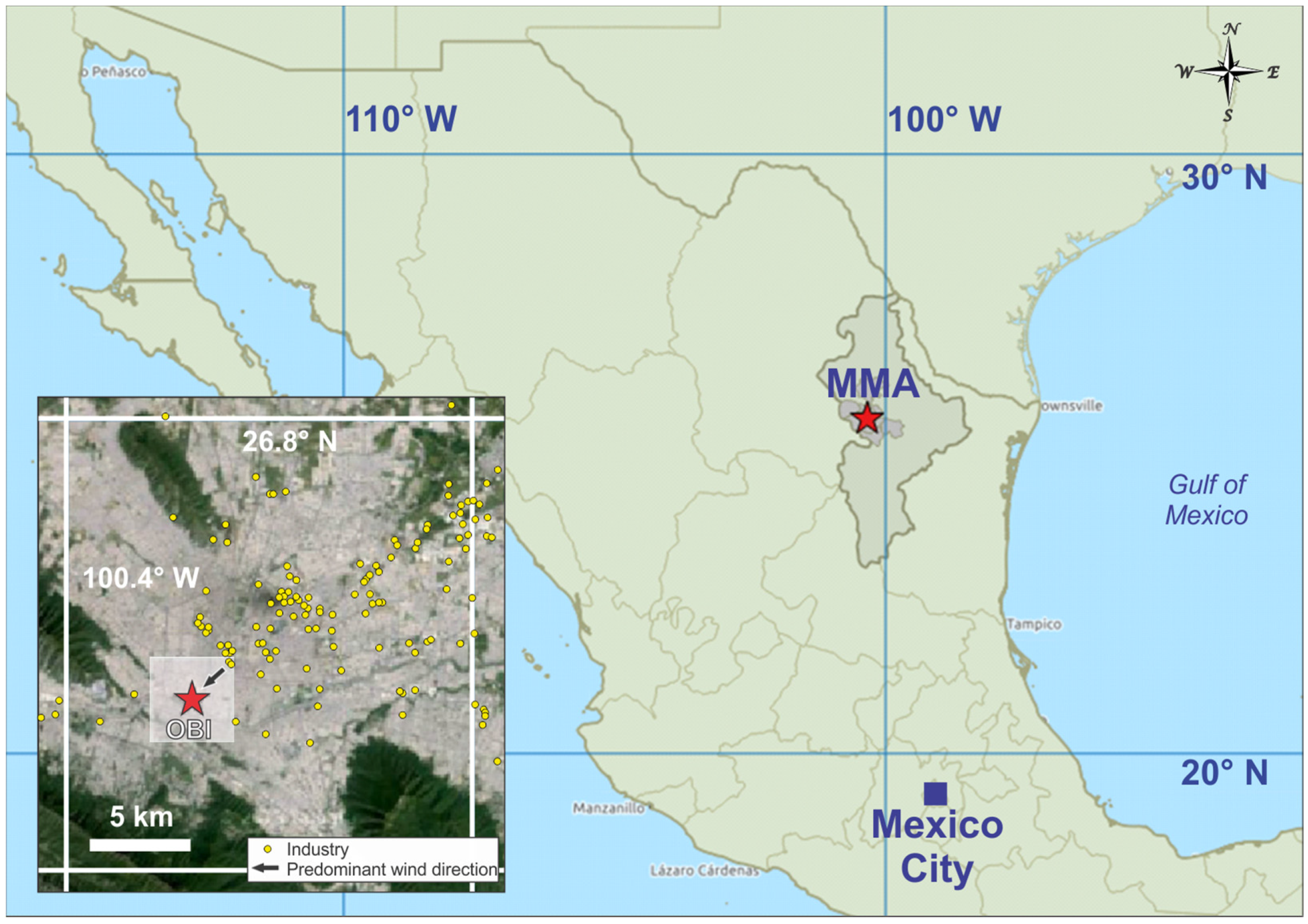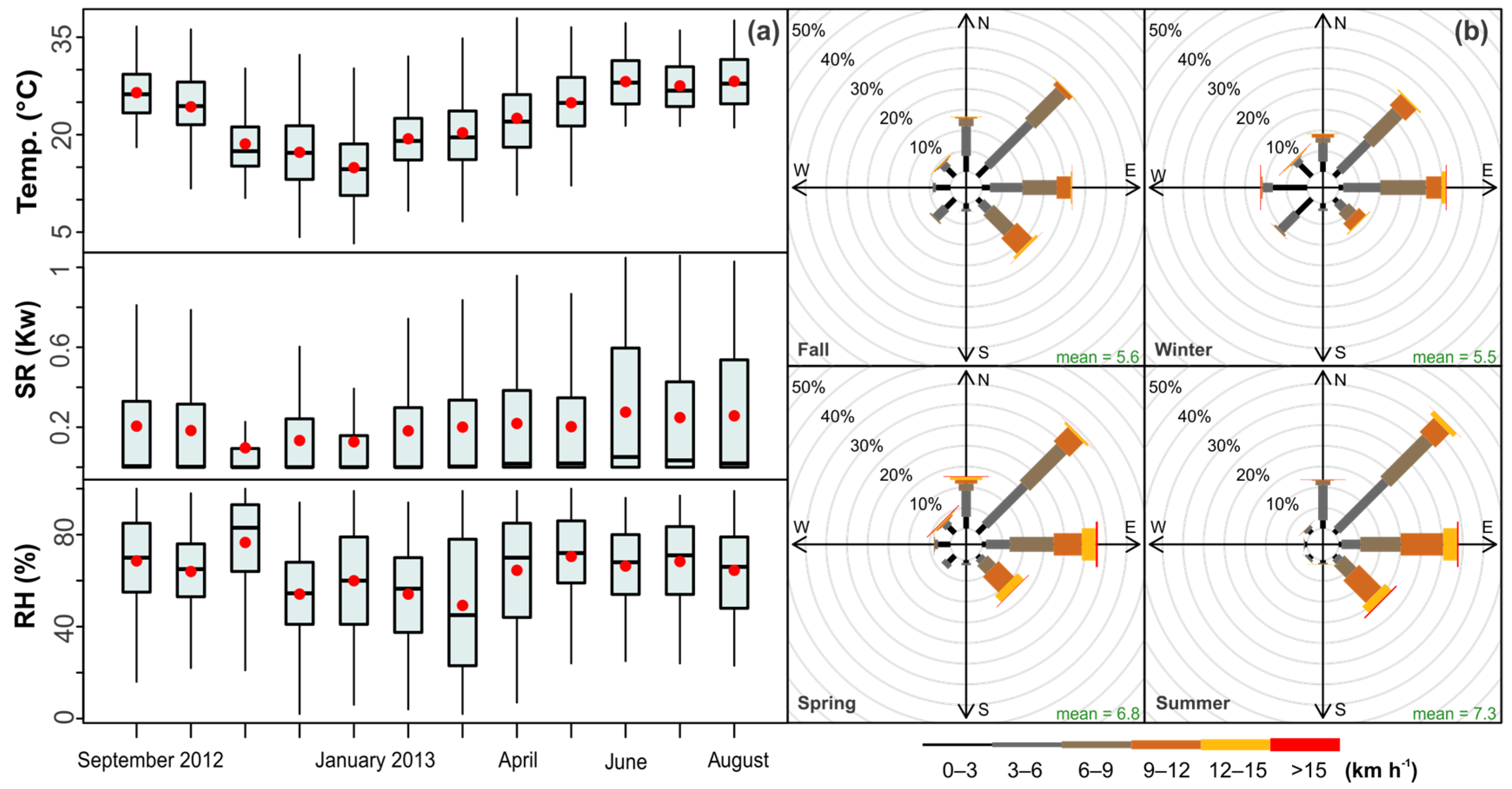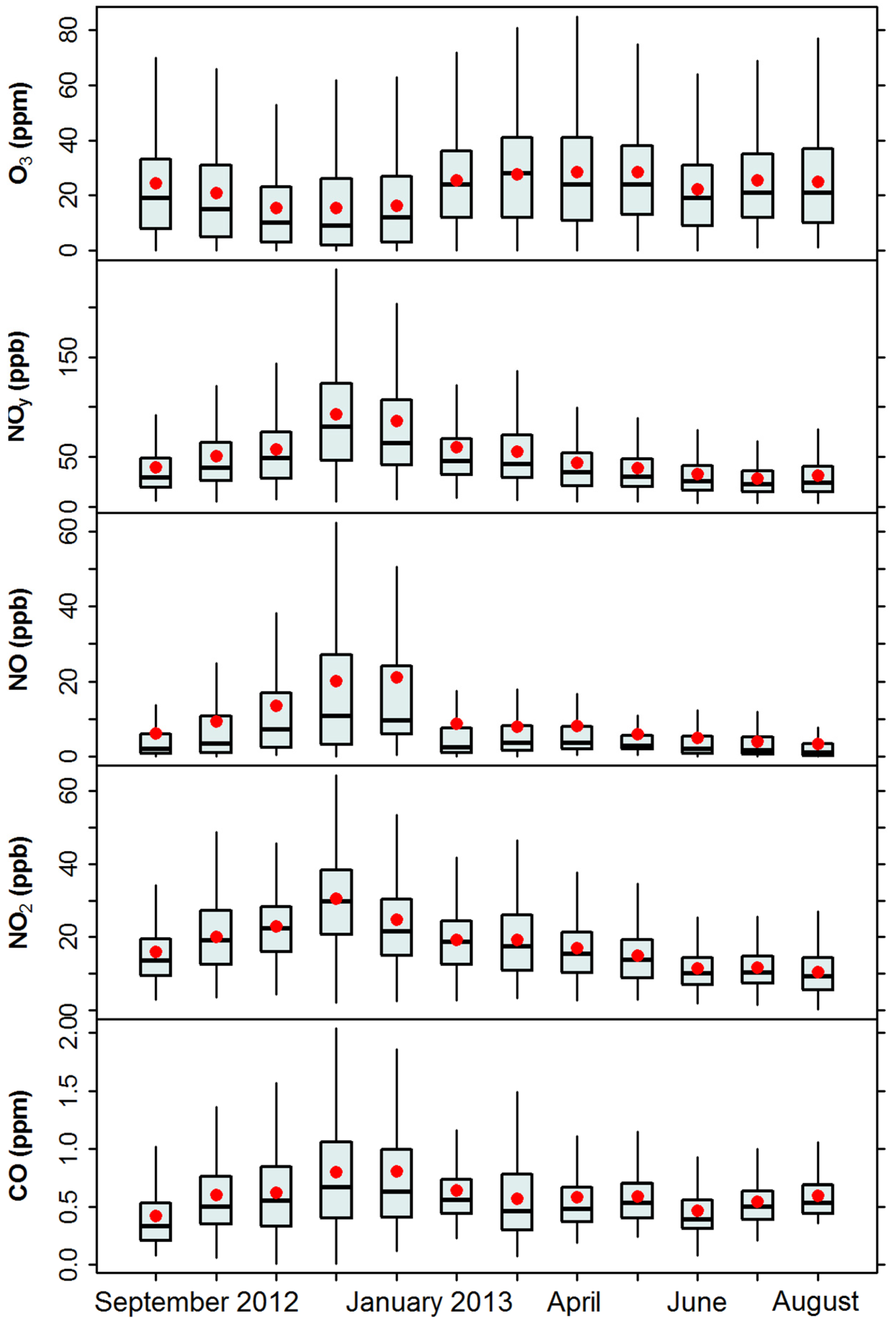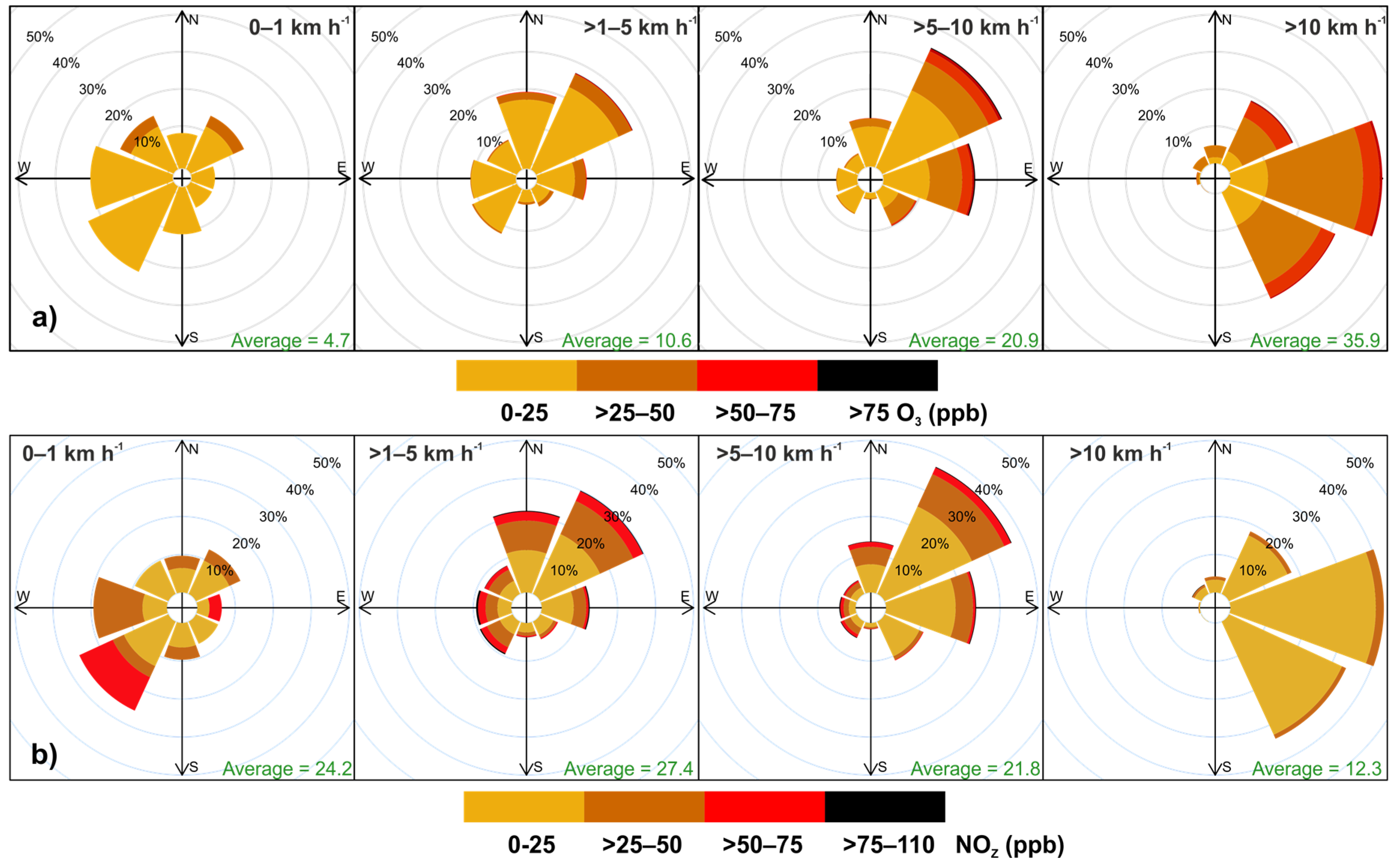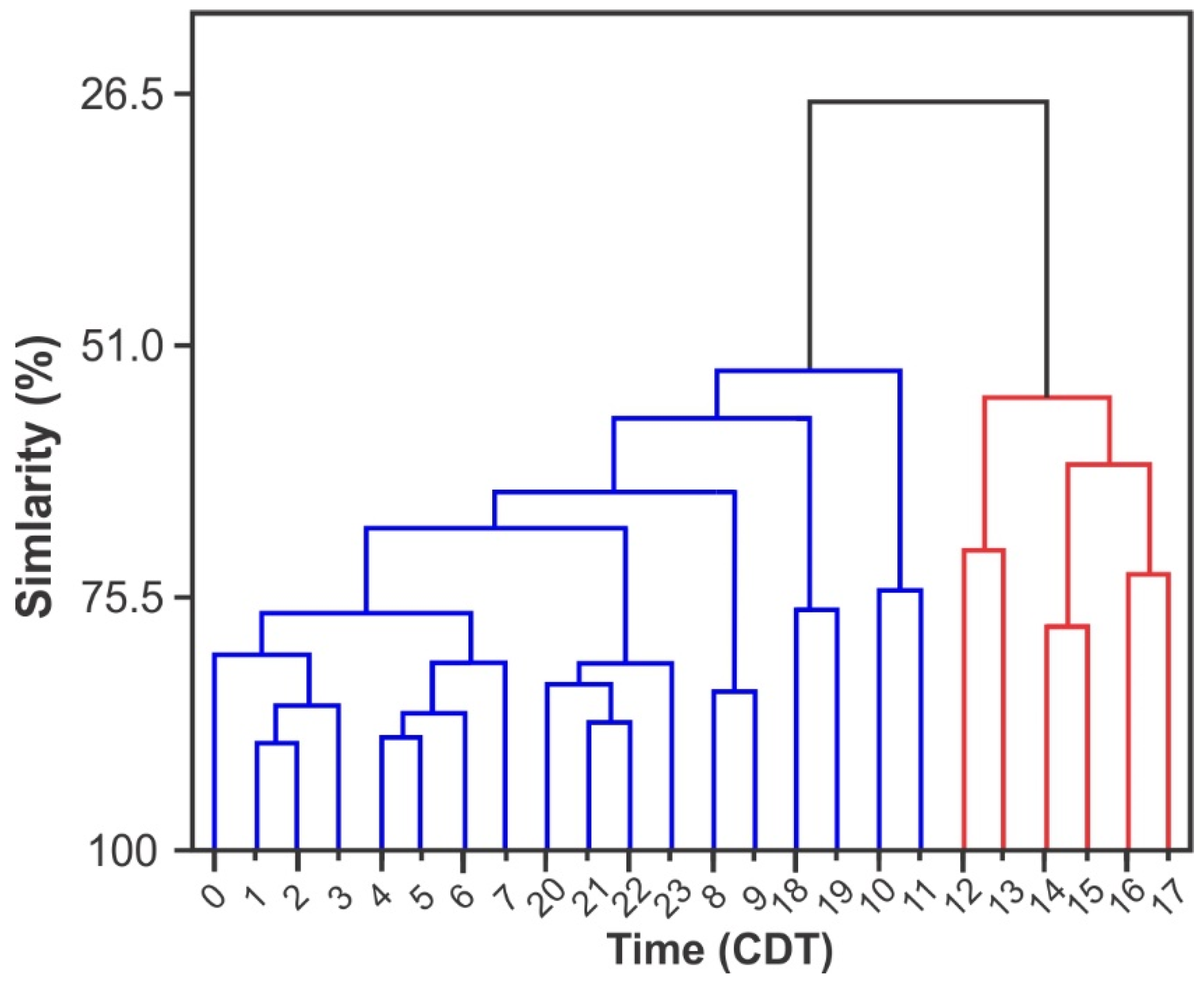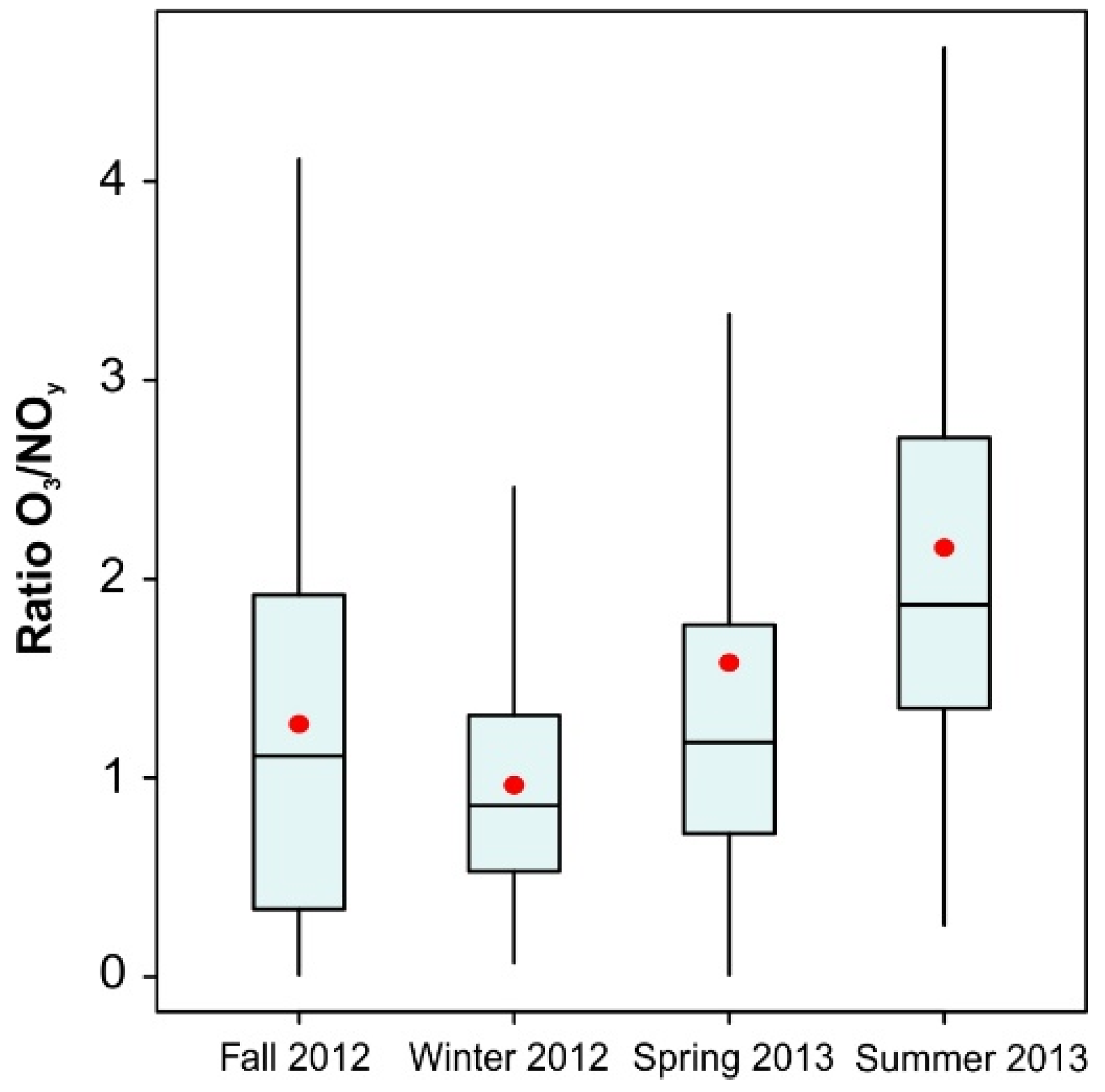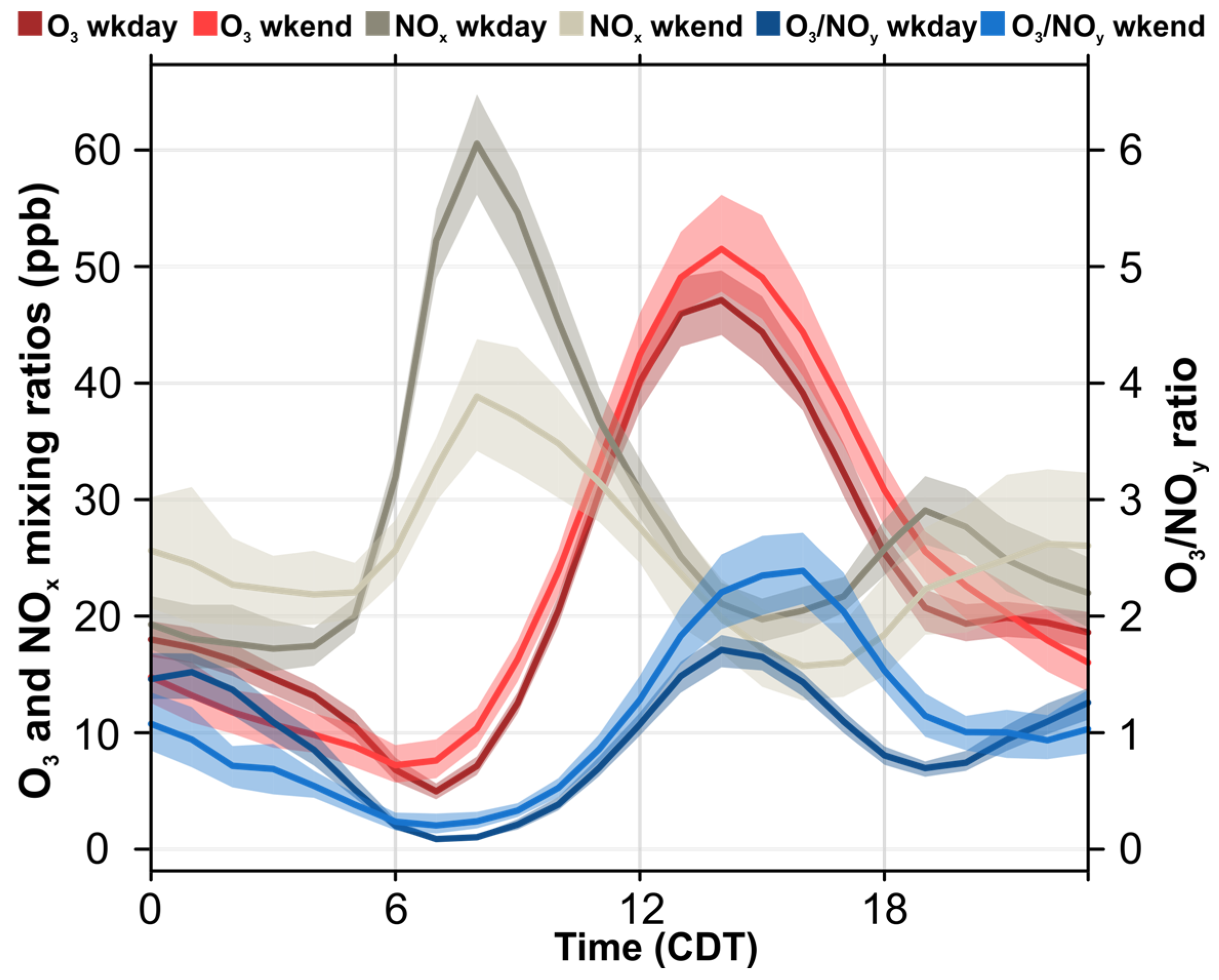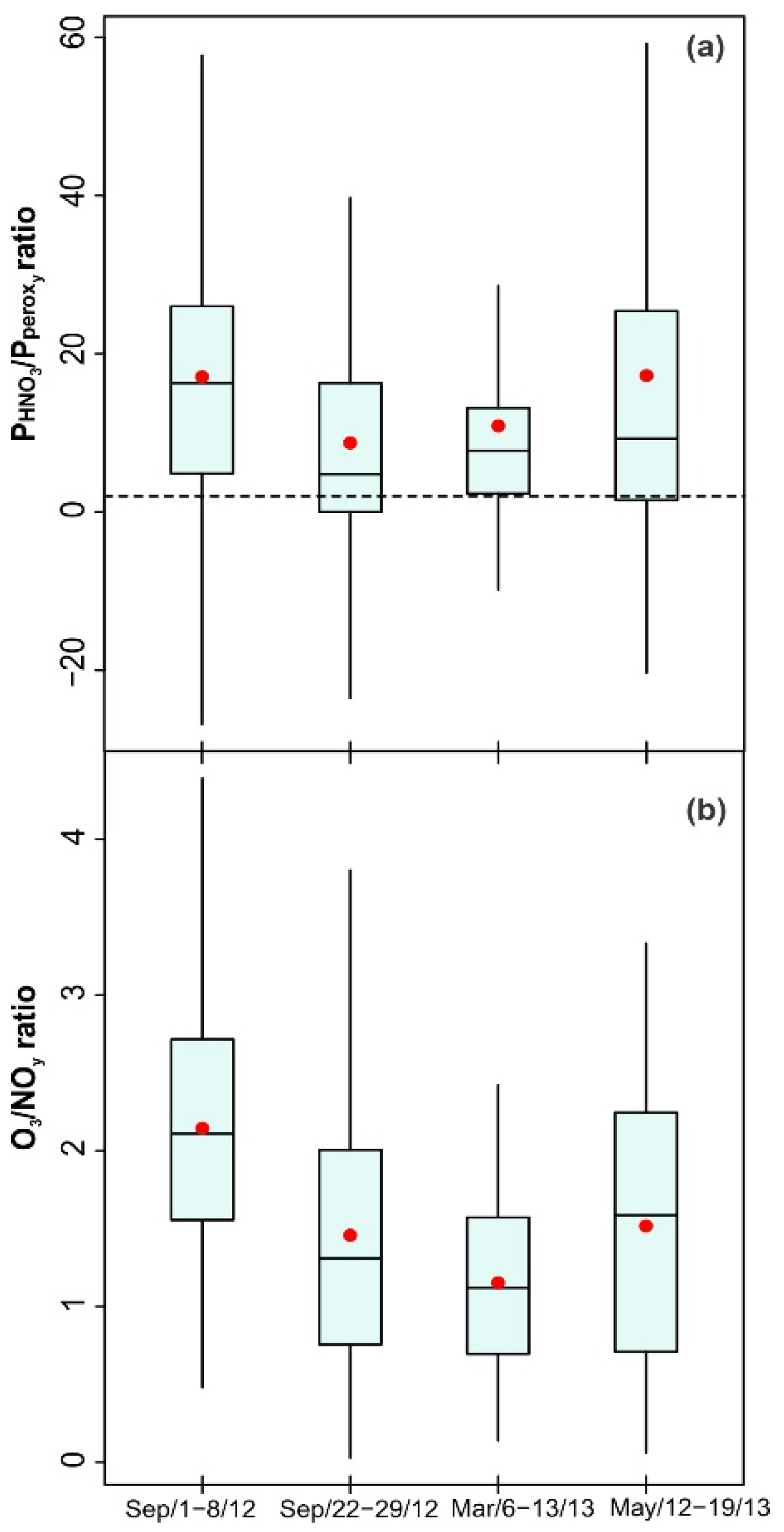1. Introduction
Increased tropospheric levels of O
3 can be harmful for human health, vegetation and built infrastructure [
1,
2,
3]. In the troposphere, O
3 is produced by photochemical reactions between volatile organic compounds (VOCs) and nitrogen oxides (NO
x = NO + NO
2) in a non-linear O
3-VOC-NO
x system not fully unraveled yet [
3]. Due to the non-linearity of the O
3-VOC-NO
x system, O
3 production can be VOC sensitive when controlled by the input of VOCs and increase in response to increased VOC emissions, but constant NO
x levels. Conversely, O
3 production can be NO
x-sensitive when NO
x emissions govern the system, and O
3 mixing ratios increase in response to increased NO
x emissions, but remain constant to variations of VOCs [
4,
5,
6]. Typical VOC/NO
x ratios for VOC-sensitive regimes are <4, while those for NO
x-sensitive regimes are >15 [
5]. However, existing studies report changes in O
3 production during the daytime and from weekdays to weekends from VOC- to NO
x-sensitive regimes and vice versa within the same region as a result of changes in the emissions of precursors and meteorology [
7,
8,
9,
10,
11]. Because the majority of existing policies to reduce the tropospheric levels of O
3 within urban areas focus on reducing the emissions of precursors, their success depends strongly on untangling, with accuracy, the sensitivity of O
3 production. The sensitivity of the O
3 production system has been traditionally assessed using either photochemical box models or 3D chemistry/transport models to predict changes under different control scenarios of VOCs and NO
x emissions or observational-based approaches (
Table 1). Models are run frequently with recorded data for ambient air pollutants as input to infer the processes that govern the O
3 production. However, the accuracy of the results generated by emissions-driven models also depends on multiple assumptions in the input data (including the emission rates), which can be highly uncertain and could lead to contradictory results [
5]. It has also been reported that different modeling systems applied to the same air basin can yield different results [
12,
13]. In addition, as exemplified in
Table 1, modeling studies tend to cover short-term episodes, given the amount of resources needed to model large periods of time. Thus, an effort has to be made to choose modeling episodes that are representative of the phenomena being addressed.
The observational methods to assess the O
3 production sensitivity based on datasets of robust measurements for involved species in the O
3-VOC-NO
x system represent a feasible alternative to the traditional modeling approach. One advantage of this approach over pure modeling studies is that larger time frames (several months or more worth of data) can be used (
Table 1). Some of the typical photochemical indicators used in the observational approach are hydrogen peroxide (H
2O
2) [
5,
18,
20], nitric acid (HNO
3) [
5,
18,
20], total odd nitrogen (NO
y = NO + NO
2 + peroxyacetyl nitrate (PAN) + HNO
3 + other inorganic and organic nitrates) [
12,
21,
22] and the O
3/NO
y ratio [
23,
24,
25]. For example, from a numerical assessment conducted for six polluted regions in the U.S., O
3/NO
y ratios ≤ 6 and ≥8 were determined for VOC- and NOx-sensitive regimes, respectively, when mixing ratios of O
3 are >100 ppb; and O
3/NO
y ratios ≤ 11 and ≥15 in VOC- and NO
x-sensitive conditions, respectively, in environments of O
3 mixing ratios < 80 ppb [
25]. In Southern Taiwan, two VOC-sensitive urban areas with O
3/NO
y ratios < 6 and one NO
x-sensitive area with O
3/NO
y ratios > 7 were observed during 2003–2004 [
18]. O
3/NO
y average ratios of 5.1 ± 3.2 and 13.6 ± 4.7 for VOC- and partially NOx-sensitive O
3 production, respectively, at two sites in Valencia, Spain, were observed during 2010–2011 [
26]. The observed variations in the O
3/NO
y ratios both for VOC- and NOx-sensitive regimes arise from different behaviors of the indicator relative to the environmental conditions (clean, moderately polluted or highly polluted environments) [
25].
The photochemical indicators that have been used arise from the analysis of the main reaction pathways of the O
3-VOC-NO
x system. In a simplified manner, the initial steps of the oxidation of VOCs in the atmosphere can be represented by the following reactions [
25]:
(where R is a general hydrocarbons chain)
(where R’ is an intermediate VOC)
O
3 accumulates in the atmosphere as NO is transformed to NO
2 (through Reaction 2) without destroying O
3; i.e., as the NO + O
3 → NO
2 + O
2 reaction becomes less relevant because of the presence of VOCs that provide a source of odd hydrogen radicals that foster other reactions. Thus, the prevalence of a given photochemical regime is driven by the chemistry of hydrogen radicals. For example, it has been shown that the chain terminating steps that involve the formation of peroxides (Reactions 5 and 6) and nitric acid (Reaction 7) compete as radical sinks, and if peroxides dominate, then a NO
x-sensitive condition will occur [
5,
25]. Similar theoretical arguments are provided to justify the use of NO
y as a photochemical indicator: the split between regimes can be established from the strength of odd nitrogen sources against odd hydrogen sources. Further details can be found elsewhere [
5,
25].
In Mexico City, a VOC-sensitive regime was determined for most of the urban area using the O
3/NO
y, O
3/NO
z and NO
y indicators derived from tropospheric measurements made at three monitoring sites within the city [
12]. In addition, a numerical simulation carried out by a 3D photochemistry/transport model was used to estimate the transition values of the indicators between regimes for a two-week period in April 2004; the transition value was ~8.1, and the average O
3/NO
y at the studied site was 2.6. Besides Mexico City, other large metropolitan areas in the country also experience frequent O
3 episodes, although they have received relatively little attention. For instance, the Monterrey Metropolitan Area (MMA;
Figure 1), which is the third-largest metropolitan area in Mexico, has historically experienced high levels of O
3, PM
10 and PM
2.5. Official reports show that within the MMA, breaches of the 1 h 110 ppb and running 8 h 80 ppb O
3 official Mexican standards (Norma Oficial Mexicana or NOM, in Spanish) were frequent during 2000–2013 [
27].
At the Obispado monitoring site (OBI) located near the downtown area of Monterrey (
Figure 1), the O
3 1 h NOM was exceeded annually between two and 17 times during 2000–2013, whereas the O
3 running 8 h NOM was breached between four and 38 times during the same period. Furthermore, an increase in the frequency of breaches of both the O
3 1 h average and the O
3 running 8 h average is expected due to the introduction of lower standard values of 95 and 70 ppb, respectively, applicable since October 2014. This highlights the importance of untangling the O
3 production sensitivity system to introduce effective emission controls, which can lead to an improvement in the air quality within the MMA. To date, only one study has recently assessed the O
3 production sensitivity system within the MMA [
19]; a VOC-sensitive regime was observed based on numerical simulations performed with the Community Multi-scale Air Quality (CMAQ) model. However, those results come from a six-day O
3 episode during summer 2005, which may not be representative of the environmental conditions prevailing the rest of the year [
19].
This study presents the assessment of the O3 photochemical production regime within the MMA over a one-year period carried out by combining box-modeling and observational approaches to analyze the behavior of two photochemical indicators. The photochemical indicator O3/NOy was derived from recorded data within the MMA for tropospheric air pollutants from September 2012 to August 2013, which was used to analyze the O3 production system. Ratios of the HNO3 and total peroxide production rates (PHNO3/Pperox) were computed using a box-model and were subsequently employed to evaluate the results derived from the recorded ambient data. Additionally, the existence of a weekend effect in the O3 production within the MMA was evaluated using the O3/NOy and PHNO3/Pperox ratios.
